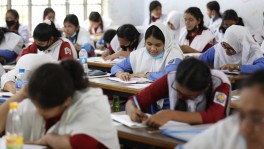Shatranji thrives on Covid lessons
The rug-making factories mushroom in Rangpur as online sales of shatranji revitalised the ailing industry
The future is uncertain, but that can be a good thing: the saying turns out to be befitting for traditional Rangpur fabric shatranji against the pandemic backdrop.
The small-scale industry of the geographical indication (GI) tagged item in northern Bangladesh had been inching towards a gradual extinction until Covid hit the country in 2020, pushing shatranji-makers online for the first time to sell the product.
After some 22 months of the pandemic, now it seems the pandemic lessons shatranji had learned was actually a game changer – turning the dying rug and carpet industry to a thriving one.
Before the pandemic, there were some four shatranji factories in north-western district Rangpur. But now 60 factories are making the product and most of the entrepreneurs are women.
"Around 60% of my sales are now through facebook pages, while 40% are offline," Monira Bagum Adori, one of the entrepreneurs, told The Business Standard.
Monira now has four shatranji-making units with more than 200 employees, while she used to weave the product at her tiny family workshop before Covid arrived.
She sold products worth Tk2 crore alone in 2021.

According to unofficial data, Rangpur'sshatranji tradition is 700 years old and the product is now going to 71 countries.
"Online and offline demand for shatranji at home and abroad is growing day by day. My business is now in a good shape'' said Sopna Rani Sen, another Rangpur-based young entrepreneur.
The main raw material for shatranji is fabric waste, jute, cotton and wool yarn. After buying those from local markets, artisans add colours to those and dry.
A worker needs 1-3 hours to weave one square foot of shatranji, while the prices range Tk150 to Tk10,000 depending on size, texture and colour.
The Bangladesh Small and Cottage Industries Corporation (Bscic) in 1978 officially undertook a project to make shatranji at a Rangpur village. There were training programmes for the artisans by non-governmental organisations too. But the projects did not yield desired outputs.
Now some 25,000 entrepreneurs and workers are dependent on the industry revitalised by online sales.
The Business Standard talked to half a dozen of shatranji-makers in Rangpur. They called for financial support to introduce automation.
Md Mafizur Rahman, managing director of the Small and Medium Enterprise Foundation (SME Foundation), told TBS they plan for setting up a common platform offering support to all small entrepreneurs.
He said SME Foundation has already requested the banks to provide Rangpurshatranji clusters with low-cost loans.


 Keep updated, follow The Business Standard's Google news channel
Keep updated, follow The Business Standard's Google news channel
















